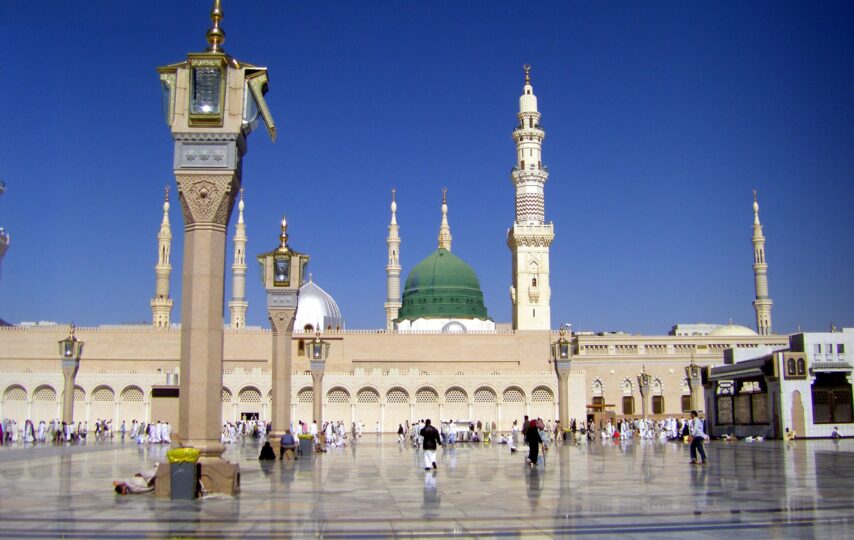It is a rare wish of every Muslim to visit the Al Nabawi Mosque at least once in a lifetime. There is a strong possibility that you will not forget to visit here during your visit to Saudi Arabia. But if have you ever been eager to know the history of Al Nabawi Mosque, then consider this article for detailed information.
Its number is second if we talk about which was the first mosque in the history of Islam, which was the Quba Mosque. The Prophet Mosque is located in the centre of Medina and is the second-holiest mosque in the world after Masjid al-Haram. Similarly, it has three gates in the south, west and east directions respectively.
Moreover, its beautiful walls, gates, and minarets attract visitors. When you first take a look at the green dome of Prophet Mosque, your eyes will likely fill with tears.
Getting to Saudi Arabia to visit the 2nd largest mosque has now become easier. Hajj or Umrah packages, tour packages etc. make it easy and affordable.
Al Nabawi Mosque – Throughout Islamic History
The Al Nabawi Mosque has its place in Islamic history. It serves as the resting place of the Prophet Muhammad (PBUH).
Here is a concise history of the Prophet Mosque:
- The First Construction
- Construction after the Battle of Khyber
- Construction under the second Rashidun Caliph Umar (R.A)
- Construction under Caliph Al-Waleed Era
- Modification during the Ottoman period
- Changes under the Saudi Authority
The First Construction
In 622 CE, the Prophet (peace and blessings of Allah be upon him) began building the mosque upon his arrival in Medina. Abu Ayyub al-Ansari paid 10,000 gold coins to two orphans (Sahl and Suhail) to buy the land for this mosque. It took seven months to build.
The mosque was built with a stone foundation, brick walls and date palm pillars. During the construction, the Prophet (peace and blessings of Allah be upon him) picked up bricks with his blessed hands. Its initial height was 11.8 feet and the roof was made of palm trunks.
Construction after the Battle of Khyber
Originally the mosque had three entrances. Their names were Gate of Mercy, Gabriel Gate and Gate of Women respectively. After the battle of Khyber in 7th Hijri, 155.2 feet (ca. 47 m) were added to the mosque compound. In addition, the west wall was built between rows of columns, which served as a prayer space.
Construction under the second Rashidun Caliph Umar (R.A)
Although the mosque was unaltered during the rule of the first Rashidun Caliph Abu Bakr (R.A). It was modified by the second Rashidun Caliph Umar (R.A). The walls of the enclosure were built from mud bricks and scattered pebbles on the ground. The height of the roof was increased to 18 feet.
In 649 CE, it was disrupted by the third Rashidun Caliph Uthman (R.A). A new rectangular shape was given to the mosque and reconstructed with stones, iron clamps, and teak wood. Now, it was in the expansion of 160 yards in length and 150 in width.
Construction under Caliph Al-Waleed Era
In 707 CE, during the Caliphate of Umayyad Caliph Al-Waleed, the governor of Medina extended the building by Caliph’s order. The mosque was built in the shape of a trapezoid, and the dimensions were extended to 200 yards (0.18 km) in length and 167 yards (0.15 km) in width. From that time, the practice of making arches in mosques started.
In 779 CE, the Abbasid Caliph Muhammad Bin Mansur Al-Mahdi mandated another expansion. The extensive use of ornamentation was replicated in previous expansions.
Modification during the Ottoman period
During the reign of Suleiman I, the east and west walls of Masjid-e-Nabwi were completed. He also added the Suleimaniyye minaret in the northeast direction. On the tomb of the Prophet Muhammad (PBUH), a brand-new steel-covered dome was installed. In 1817, Mahmud II finished building al-Rawdah al-Mutaharah, also known as the clean residence. After that, this dome was given the name “Green Dome” in 1837, after being painted green colour.
Changes under the Saudi Authority
After 400 years, the Ottoman era came to end and Saudi rule took over. Nearly every tomb and dome was demolished by Saud bin Abdul Aziz in the 1800s. But, the king did not topple the green dome.
The Al Nabawi Mosque experienced numerous changes under Saudi authority. According to the king’s directive, areas close to the mosque were expanded in 1951 to allow a way for a prayer hall. It was once more extended, and areas around it were levelled in 1985. The Masjid-e-Nabwi gained escalators and 27 courtyards in 1992. In September 2012, a billionaire project was announced to expand and modernize the mosque’s space.
Facts about Masjid-e-Nabwi
Every dome, pillar, and glass at Al Nabawi Mosque has a unique tale. These mysterious signs and symbols honour moments in history that are very crucial to Islam. Some little-known facts regarding this holy are as follows:
• The grave of Prophet Muhammad (PBUH) is located here.
• On the east of Roda Rasool is where you’ll find the door to the House of Fatima (R.A).
• Between the Pulpit and Roda Rasool is a space that is carpeted in green, called Riyadhul Jannah.
• It has three Mihrabs.
• Masjid Nabawi now has an area of 8.67 square metres, which is 100 times more than the mosque’s original size.
Summary – Al Nabawi Mosque
One of the most popular tourist attractions in Medina is Al Nabawi Mosque. It is the second-largest mosque in Saudi Arabia in terms of construction and sacredness. Furthermore, it has had numerous modifications and additions over the years. This mosque has many Ziyarats that most agencies offer when booking Hajj and Umrah packages 2023, such as the graves of the Prophet and his two companions, Riyadhul Jannah, etc.
Millions of travellers visit it each year after completing the pilgrimage.






